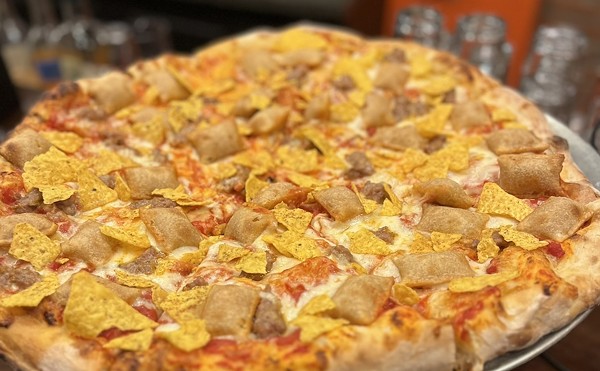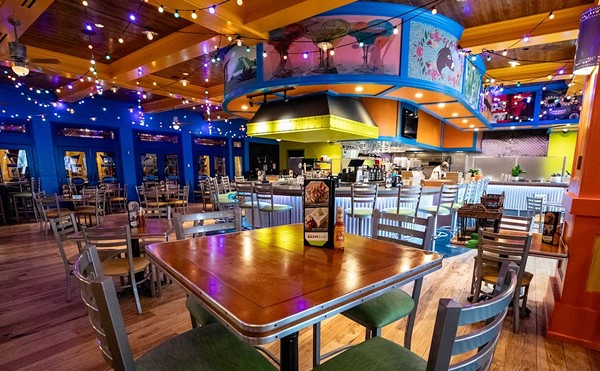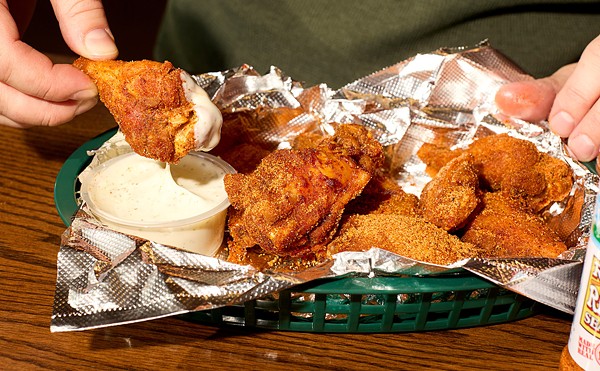"Wasn't he supposed to be the head chef at that new Voilà place in the West End?"
"Doesn't he own Le Petit Paris?"
"Remember the Caffe Paradiso coffeehouses, before Starbucks moved in? He made great crêpes there."
"He had that crêpe stall in U. City, right?"
Yes, it's all true. So is the fact that in the '90s the tall, handsome Parisian ran Chez Monet in Jefferson City and a little crêperie at Columbia's Lakota coffeehouse.
Habassi, who was born in Tunisia and raised in Paris, is as handsome and charming as ever, perhaps with a touch of salt now added to the pepper of his hair. But after all the moving around, he ought to wear the gray hairs with pride. How gutsy was it when, at the height of the "Freedom fries" absurdity, Habassi decorated each table at Le Petit Paris with little French flags?
Since 1998 Habassi and his Tunisian wife, Aouatef, have fit right in on South Grand's Asian-dominated restaurant row with their brand of "French cuisine with a Tunisian accent." Now, at his new south-county restaurant in Concord Plaza, Dinarosa Café, Habassi touts "Italian cuisine with a French accent." Here too, though, the French accent comes with a Tunisian flair. Taken as a whole, the approach might better be described as Mediterranean.
In many respects, Habassi has simply exported his South Grand menu to south county: duck a l'orange, chicken cordon bleu, filet mignon, grilled lamb and, of course, crêpes are served. The Italian flavor comes in via no fewer than fourteen pasta dishes -- and not a plain red or white sauce among them.
Like many of the rustic "peasant" pastas of Southern Italy, spaghetti alla Sicilian seems deceptively simple. The dish features tomatoes, capers and black olives, uniting the classic southern Italian triumvirate with an anchovy-based sauce. Habassi's touch with the anchovies was subtle -- perhaps too much so in a dish that features such strong flavors. For that matter, it could have used another handful of that red, green and black trio.
The delicate nature of Habassi's sauces is no accident. When boiling pasta he doses the water with a sizable measure of one stock or another, depending on what will best match the dish. And most of the time it works wonders. For example, to spaghetti alla Carthage, which features homemade merguez lamb sausage, chickpeas and a spicy marinara, Habassi adds lamb stock. The result is a plate of noodles that are gently coated with the pungent lamb-flavored sauce, not swimming in the deep end of a veritable pool.
Tunisia comes to the fore in five couscous dishes including renditions featuring lamb, vegetables, chicken and the aforementioned merguez sausage. For the seafood couscous, shrimp, mussels and chunks of salmon and tuna are tossed with black olives, green peas, onions and zucchini. Underneath, the bed of couscous is moist and flavorful, having soaked up flavor from the main ingredients, along with Habassi's marinara.
Ordering chicken cordon bleu at a restaurant is like playing Russian roulette with more than one bullet; it's too often over-breaded and occasionally deep-fried rather than sautéed -- I've even been served versions with Provel cheese. Dinarosa offers a much more delicate rendition, eschewing bread crumbs and oil entirely: After stuffing a chicken breast with cubed ham, Swiss cheese and spinach, Habassi rolls it into a log and then poaches it, finishing off the dish with a cream sauce. Poaching brings out the flavor, allowing the ingredients to meld yet remain distinct. The only setback here was a too-generous hand with the salt, which overpowered the sauce.
Italian Riviera mussels, simmered in a fragrant sauce featuring white wine and garlic butter, made for a wonderful appetizer. The starter would have been even better had it been served alongside a basket of crusty French bread. As it was, we had to ask for bread, which, we were informed, is baked to order from frozen dough. Even sadder to say, the dough is reminiscent of the Pepperidge Farm variety, bland as a kitchen sponge.
Most nights Habassi comes out of the kitchen in his chef's coat, skittering from table to table and chatting with diners in his smooth French. On one visit, service was provided by the restaurateur's good friend Chris Heisler. A partner in the erstwhile Bella Cita Mediterranean restaurant on the Hill, Heisler is a certified sommelier and proved an able guide through the wine list. Thirty-six bottles are available, mostly Italian and French with a smattering from California. Some of the better values: a 2001 Château Montcontour Vouvray ($7 per glass, $25 a bottle); and a light, fruity 2003 Maculan Pino & Toi (a blend of pinot bianco, pinot grigio and tocai grapes that goes for $6 and $22, respectively).
For dessert you'd be foolish to skip one of Habassi's crêpe creations, such as the "Millennium," a thin, airy crêpe filled with bananas and melted chocolate and topped with a fragrant orange sauce, whipped cream and toasted hazelnuts. A veteran of the Cordon Bleu in Paris, Habassi obviously learned a thing or two about transforming a pancake into a masterpiece.
With the addition of Dinarosa to his résumé, some are undoubtedly asking, "How does he run two restaurants?" Habassi's wife now runs the kitchen at Le Petit Paris, where they've cut back the dinner hours and made their civilized lunch experience available only for private parties. For now, at least, Habassi seems to have found his niche concentrating on his own operations rather than teaming up with others.





